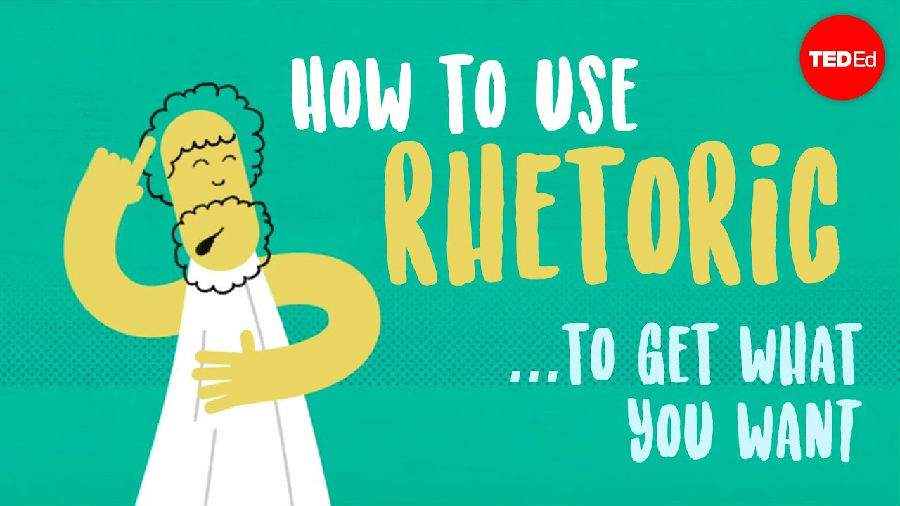(单词翻译:单击)
How do you get what you want using just your words?
如何用自己的语言得出结果?
Aristotle set out to answer exactly that question over 2,000 years ago with the Treatise on Rhetoric.
早在2000多年前,亚里士多德就通过关于修辞的专门论述开始回答这个问题了。
Rhetoric, according to Aristotle, is the art of seeing the available means of persuasion.
修辞学,根据亚里士多德的观点,是用不同方式说服他人的艺术。
And today we apply it to any form of communication.
如今,修辞学被广泛运用于各种交流场合。
Aristotle focused on oration, though, and he described three types of persuasive speech.
然而,亚里士多德当时专注于演说,而且,他阐述了三大说服性演讲类别。
Forensic, or judicial, rhetoric establishes facts and judgements about the past, similar to detectives at a crime scene.
辩论型,或者叫做审议型修辞手法,根据既成事实与判断得出结论,类似于置身于犯罪现场的警探。
Epideictic, or demonstrative, rhetoric makes a proclamation about the present situation, as in wedding speeches.
修饰型,或者叫做抒发型修辞手法,通常是重申某种现实状况,比如说,婚礼致辞。
But the way to accomplish change is through deliberative rhetoric, or symbouleutikon.
然而,审议修辞是达到目和促成改变的重要手段,或叫做象征型修辞。
Rather than the past or the present, deliberative rhetoric focuses on the future.
审议修辞既不关注过去,也不着眼现状,而是专注于未来。
It's the rhetoric of politicians debating a new law by imagining what effect it might have,
政治家们运用这样的审议修辞来辩论一个新法案会带来的影响,
like when Ronald Regan warned that the introduction of Medicare would lead to a socialist future
就像罗纳德·里根警告美国老年人医疗保险制度有可能给我们的下一代传达一种社会主义思想,
spent telling our children and our children's children what it once was like in America when men were free.
并且会代代相传下去曾经那个人人自由的美国社会。
But it's also the rhetoric of activists urging change,
同时该修辞也是活跃分子寻求改变的方式,
such as Martin Luther King Jr's dream that his children will one day live in a nation
就像马丁·路德·金关于梦想的演讲,他的子孙后代终有一天会生活在一个国度,
where they will not be judged by the color of their skin, but by the content of their character.
那里,人们不会因为他们的肤色受到歧视,每个人的品行才是判断的标准。
In both cases, the speaker's present their audience with a possible future
以上这两个案例中,演讲者都为听众描绘了可能的未来,
and try to enlist their help in avoiding or achieving it.
并且希望得到听众们的帮助,以此避免或实现那样的结果。
But what makes for good deliberative rhetoric, besides the future tense?
但是除了描绘未来场景,还能如何打造有效的审议修辞型的演讲?
According to Aristotle, there are three persuasive appeals: ethos, logos, and pathos.
根据亚里士多德的观点,有三种方式:认知、标识和同情心。
Ethos is how you convince an audience of your credibility.
通过和听众的认知达成一致,演讲者可以建立起可信度。

Winston Churchill began his 1941 address to the U.S. Congress by declaring,
温斯顿·丘吉尔1942年美国国会的演说,开场白:
'I have been in full harmony all my life with the tides which have flowed on both sides of the Atlantic against privilege and monopoly,'
“太平洋两岸的潮汐一直和谐地流动在我的生命中,一直对抗着特权和垄断,”
thus highlighting his virtue as someone committed to democracy.
从而突显出他一直致力于民主推广的美德。
Much earlier, in his defense of the poet Archias,
早在古代,在为诗人阿基亚斯辩护的演讲中,
Roman consul Cicero appealed to his own practical wisdom and expertise as a politician:
罗马执政官西塞罗通过自有的实践智慧,以及身为政治家的专业素质:
'Drawn from my study of the liberal sciences and from that careful training to which
“无论是我自身的文学教育,还是专注的训练体系中,
I admit that at no part of my life I have ever been disinclined.'
我承认,我生活中没有任何一个部分遭到了厌恶。”
And finally, you can demonstrate disinterest, or that you're not motivated by personal gain.
最终,你可以通过证明事不关己,或者你是无偿奉献的精神来说服听众。
Logos is the use of logic and reason.
理性修辞是通过逻辑和推理来表达观点。
This method can employ rhetorical devices such as analogies, examples, and citations of research or statistics.
该方式可以通过类比、举例以及科研引用和数据来进行论述。
But it's not just facts and figures. It's also the structure and content of the speech itself.
但是这不仅仅是事实和数字。更重要的是演讲本身的结构和内容。
The point is to use factual knowledge to convince the audience, as in Sojourner Truth's argument for women's rights:
关键在于用事实去说服听众,就像索茹尔内·特鲁斯关于女权的观点一样:
'I have as much muscle as any man and can do as much work as any man.
“我拥有比得上任何一位男性的力量,并且可以做同样的工作。
I have plowed and reaped and husked and chopped and mowed and can any man do more than that?'
我耕地、收割、去壳、伐木、割草,有任何一个男人可以做得更多吗?”
Unfortunately, speakers can also manipulate people with false information that the audience thinks is true,
不幸的是,演讲者也会利用错误的信息来愚弄听众,让听众信以为真,
such as the debunked but still widely believed claim that vaccines cause autism.
比如已经被辟谣,但是依然广泛被相信的谣言:疫苗会导致自闭症。
And finally, pathos appeals to emotion, and in our age of mass media, it's often the most effective mode.
最后一种方式,同情,是引起情感上共鸣的技巧,在现今大众传播媒体社会,这也是最有效的方式。
Pathos is neither inherently good nor bad, but it may be irrational and unpredictable.
同情本身并没有好坏对错之分,但是有可能变得不理性、难预测。
It can just as easily rally people for peace as incite them to war.
就像怜悯可以轻易团结民众一样,也可以教唆战争。
Most advertising, from beauty products that promise to relieve our physical insecurities
大部分的广告,从美容产品保证可以减轻人们对自己身体的不安全感,
to cars that make us feel powerful, relies on pathos.
到可以让人们感觉力量倍增的汽车,都依赖于情感上的共鸣。
Aristotle's rhetorical appeals still remain powerful tools today,
亚里士多德的修辞学说现今也依然是个强有力的工具,
but deciding which of them to use is a matter of knowing your audience and purpose, as well as the right place and time.
但是选择使用哪一种方式,取决于熟悉讲演的受众以及目的,并且也和时间地点息息相关。
And perhaps just as important is being able to notice when these same methods of persuasion are being used on you.
同时,作为听众时能够辨别这些说服技巧的能力也是一样的重要。


